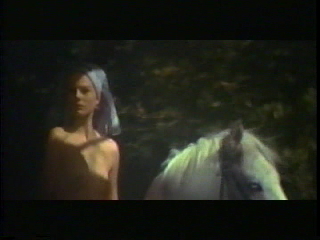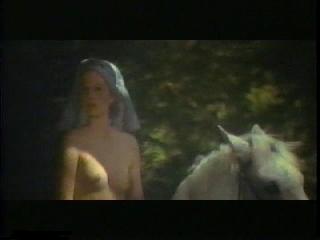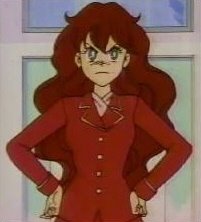Zardoz Screenshots
I haven't posted for over a month but still my site counter registers a trickle of hits, a spectral half-life composed of random searches and old links. Recently I noticed many hits were coming from the same Google page, which must be preserved in a link somewhere -- but where? -- a page of results for "Zardoz screenshots." On it, my site has moved up steadily from the second page to the top five.
That's what I get for trying to be campy.
As this is the largest response my blog has ever gotten, I can only oblige, even if you web rats never leave comments. Here's an index of Zardoz screenshots on this site:
Zardoz, the science fiction film (3)
Zardoz, the horror movie (part of my Halloween horror theme) (6)
Zardoz, the horror movie II (6)
Zardoz, the horror movie III (6)
Zardoz, the fantasy film (6)
Zardoz, the fantasy film II (6)
This post (2 old/3 new)
Zardoz: the Vortex (7)
Zardoz: Eye, Third Eye, and Tabernacle (9)
Zardoz: "O Consuella" (3)
Zardoz, the head film (6)
Zardoz, the head film II (6)
Zardoz, the head film III (6)
Zardoz, the head film IV (6)
Zardoz, post-apocalyptic action film (6)
Incidently, these screenshots are not from the DVD. They are from a VHS tape of a cable showing sometime in the late '90s. Despite not showing the full widescreen image -- and, looking at some of the images here, you can see where they were trimmed -- it comes much closer to the theatrical images I remember; rich, darkling, painterly. The DVD, though it's gotten good reviews, looks way too bright and clear to me, as if some unsympathetic technician had turned the knobs all the way up.
The creator of Zardoz, John Boorman, talks a little about its look and its cinematographer in his autobiography, Adventures of a Suburban Boy. "I had the great Geoffrey Unsworth as cameraman on [Zardoz]. He was a soft-spoken, courteous man, with the air of a distracted wizard. When colour arrived, cameramen continued to light as they had done for black and white, using shafts of direct light to separate objects and differentiate the various planes. Film is two-dimensional: lighting and camera movement are concerned with creating the illusion of a third dimension. In the black-and-white days on a typical set you would see a forest of black flags, arranged to allow slivers of light to pinpoint particular spots. Geoffrey, however, realised that colour did the job of distinguishing objects from each other, and that direct light made the colours very harsh and brash. He devised a radical new approach to colour lighting, using only indirect soft light. He combined this with diffusion filters, wide-open apertures in the lenses, and smoke on the sets, to soften and blend the elements together, rather than differentiating between them. It was the absolute contrary of the former style, attempting to meld the characters and the settings together, rather than differentiating between them. The result resembled an impressionist painting.
"The studios hated this technique. Subjected to mass, high-speed printing, the picture would tend to collapse into a fuzzy mush. It also looked murky on videotape and television. Today, the studios demand a crisp, sharp image, although all cameramen now use Geoffrey's system of indirect lighting." I wonder if something related happened to the DVD.

Some of you not only look at these images but upload them. Curiously, it's always one of the same two:


I sense a pattern. Think they'd prefer these?


That's what I get for trying to be campy.
As this is the largest response my blog has ever gotten, I can only oblige, even if you web rats never leave comments. Here's an index of Zardoz screenshots on this site:
Zardoz, the science fiction film (3)
Zardoz, the horror movie (part of my Halloween horror theme) (6)
Zardoz, the horror movie II (6)
Zardoz, the horror movie III (6)
Zardoz, the fantasy film (6)
Zardoz, the fantasy film II (6)
This post (2 old/3 new)
Zardoz: the Vortex (7)
Zardoz: Eye, Third Eye, and Tabernacle (9)
Zardoz: "O Consuella" (3)
Zardoz, the head film (6)
Zardoz, the head film II (6)
Zardoz, the head film III (6)
Zardoz, the head film IV (6)
Zardoz, post-apocalyptic action film (6)
Incidently, these screenshots are not from the DVD. They are from a VHS tape of a cable showing sometime in the late '90s. Despite not showing the full widescreen image -- and, looking at some of the images here, you can see where they were trimmed -- it comes much closer to the theatrical images I remember; rich, darkling, painterly. The DVD, though it's gotten good reviews, looks way too bright and clear to me, as if some unsympathetic technician had turned the knobs all the way up.
The creator of Zardoz, John Boorman, talks a little about its look and its cinematographer in his autobiography, Adventures of a Suburban Boy. "I had the great Geoffrey Unsworth as cameraman on [Zardoz]. He was a soft-spoken, courteous man, with the air of a distracted wizard. When colour arrived, cameramen continued to light as they had done for black and white, using shafts of direct light to separate objects and differentiate the various planes. Film is two-dimensional: lighting and camera movement are concerned with creating the illusion of a third dimension. In the black-and-white days on a typical set you would see a forest of black flags, arranged to allow slivers of light to pinpoint particular spots. Geoffrey, however, realised that colour did the job of distinguishing objects from each other, and that direct light made the colours very harsh and brash. He devised a radical new approach to colour lighting, using only indirect soft light. He combined this with diffusion filters, wide-open apertures in the lenses, and smoke on the sets, to soften and blend the elements together, rather than differentiating between them. It was the absolute contrary of the former style, attempting to meld the characters and the settings together, rather than differentiating between them. The result resembled an impressionist painting.
"The studios hated this technique. Subjected to mass, high-speed printing, the picture would tend to collapse into a fuzzy mush. It also looked murky on videotape and television. Today, the studios demand a crisp, sharp image, although all cameramen now use Geoffrey's system of indirect lighting." I wonder if something related happened to the DVD.

Some of you not only look at these images but upload them. Curiously, it's always one of the same two:


I sense a pattern. Think they'd prefer these?




0 Comments:
Post a Comment
<< Home